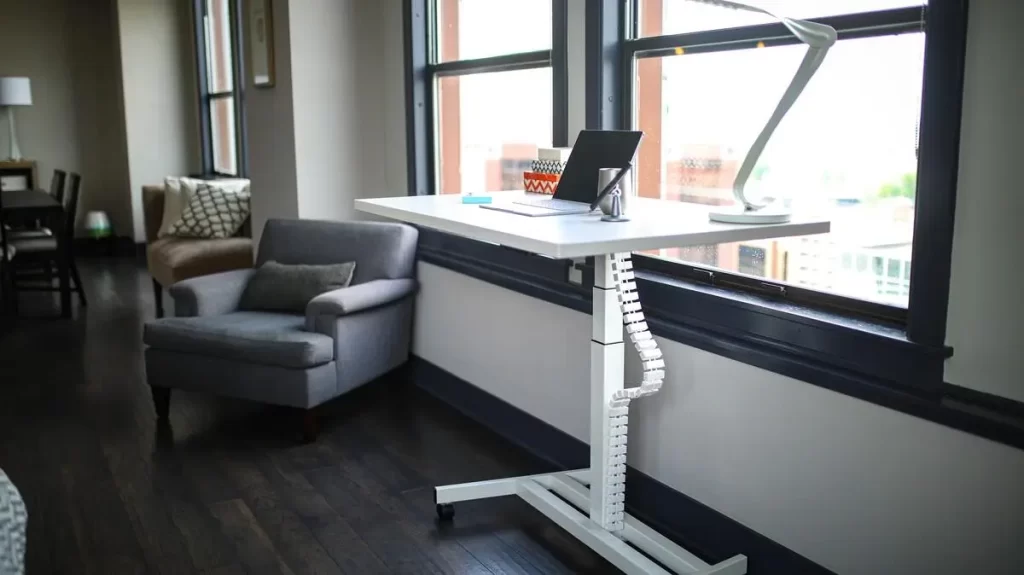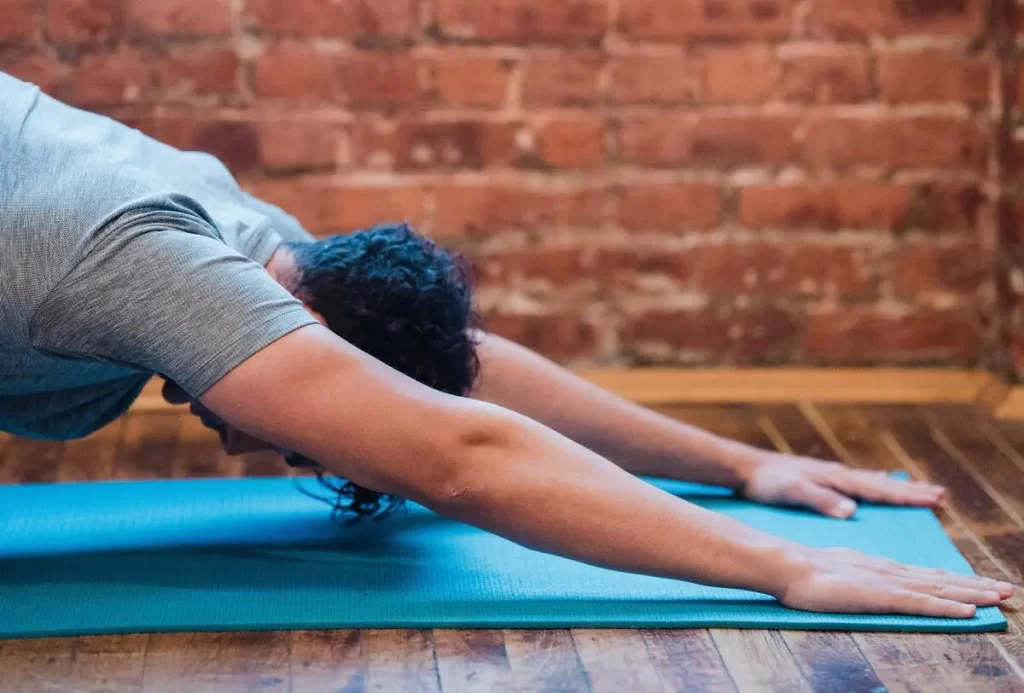
If you have started making the switch from sitting all day to standing, congrats. Yet, learning how to get used to standing at work is not a straightforward feat. Many people give up trying to stand while working prematurely when they realize that a standing desk does not ease their bodily discomfort right away. Dips in productivity do not help either.
In terms of getting used to a standing desk, it could take at least two weeks for your body to physically adapt to the stress of standing. Your productivity levels may dip slightly or be unaffected. Thereafter, it is realistic to expect an improvement in productivity after the first month of using a standing desk.
There are some best practices that can ease your transition and help you to develop the ability to stand for long periods of time.
How long does it take to adapt to standing?
One of the discouraging things about using a standing desk, as a beginner, is the realization that a standing desk is not a magical ‘hack’.
Standing at a desk is somewhat new to us — it is a new aspect of a less sedentary lifestyle. It takes time before your body learns a new way of working, being, and thriving.
In a study of call center employees, it was found that productivity improvements were not very significant within the first month when employees started using stand-capable desks.
However, from the second month onwards, productivity improvements start to skyrocket.
After six months, standing desk users were about 46 percent more productive than those who kept using their traditional, seated desks.
An interesting fact is that these workers at standing desks only sat about 96 minutes less per day. Their stand-capable workstations allowed them to raise or lower their desks whenever they wanted; they could optimize their configurations as and when they decided to.
This shows that you do not need to obsess over standing for hours and hours on end. It is not necessary to justify that you have maximized your investment in a standing desk by making your body take on more stress than it could handle.
Physical Adaptation and Productivity
In fact, productivity might actually decline during the first few weeks, due to the new experience of physical stress.
Observe your productivity levels. The longer the duration you are able to focus at your standing desk, the better your body has adapted. This is a sign that your body has learned to associate productivity not just with sitting, but also with standing.
Expect this adaptation process to take at least two weeks.
Rather than standing for many consecutive hours (like you would when seated at a desk job for 8 hours), you will need to alternate between sitting and standing. This will help ease your transition.
- Switching frequently between sitting and standing, throughout the course of the day, can be a really healthy way to approach desk work — it ensures that no aspects of your health, productivity, and well-being are sacrificed.
There are many ways you could integrate more standing into your workday.
Tasks like research, replying to emails, and learning a new skill or subject are perfect tasks for standing desk work. They are tasks that can be done in short bursts of time, twenty to thirty minutes at a time.
Learning the best ways to incorporate these tasks into your standing workday can help you maximize unproductive hours, and squeeze in the extra work during your unfocused afternoon and evening hours.
Besides realistic expectations, you would also need to know the basics of ergonomics to ensure that you are standing correctly. Many people do not know about ergonomics – not even the basics. The basics are really simple. Side note: Scan through the above article to ensure you are not making those 10 simple mistakes; a small handful of them combined can silently kill your productivity.
Basically, ensure that your standing desk is at a height that allows these conditions:
- Comfortable typing when you stand or sit: Your elbows should be positioned at an ideal 90-degree angle, with your arms parallel to the floor when rested on the desk.
- Height of laptop or monitor screen: The top line of your laptop or monitor will be at or just below eye level when atop your standing desk. Avoid looking downwards with your neck or bending down to look at your screen.
Taking care of such ergonomics will ensure that your workspace is set up correctly. It helps your body adapt without encountering new and preventable challenges, pains, and bad posture.
Train Yourself: Best Practices for Using A Standing Desk
We can better get used to a standing desk by learning some of the best practices. Just like prolonged sitting, there are risks for prolonged standing. A longitudinal study involving over 38,000 subjects found that people who stood or walked for more than six hours a day developed a doubled or tripled risk of requiring surgery for varicose veins. These are highly visible, misshapen veins on your legs, associated with pain, swelling, and potential health issues further down the road.
Thus, even with a standing desk, you should know the following:
- Standing for more than four hours a day is not recommended, based on the Prolonged Standing Strain Index.
- Office workers who stood for two hours consecutively reportedly felt discomfort in all body regions, especially in the lower back and limbs. Their reaction time and mental state deteriorated following the two hours of standing.
What is the ideal sit/stand duration then? In a study of twelve office workers, it was found that they preferred sit/stand durations in the range between 1:1 and 3:1. This means that if they sat for 30 minutes, they would stand for a period of at least 10 minutes, or somewhere between 10-30 minutes. Such sit/stand schedules have proven to reduce muscle fatigue and work-related musculoskeletal disorders.
This is not exhausting at all – any beginner, including yourself, would be able to pull this off safely.
Another study found that workers who switched between sitting and standing every 30 minutes across the workday experienced a significant decrease in fatigue levels and lower back discomfort while maintaining productivity.
Stand for 30-minute periods, and sit for the next 30 minutes or longer if you like. Above all, we recommend that you find your personal best standing intervals. Understand this:
- Be realistic — start with a total of 1-2 hours of standing per day, until you feel comfortable enough to increase your standing hours
- Use a simple rule: Sit back down when you feel tired. Of course, you can set a 20-30min timer, if you tend to forget to stand back up.
Setting a timer is a habit that would come naturally if you are already using time management practices, such as the Pomodoro technique to stay on track of time.
This article was originally published on unboundist.com. If it is now published on any other site, it was done without permission from the copyright owner.
Improve your ability to stand for longer periods
Anyone can improve their ability to stand for long periods of time. This involves training your body with simple stretches and movement.
Strength Training
The most important muscles to strengthen would be your core muscles and the muscles in your lower body.
Strengthening the muscles in your core can help to prevent lower back issues. There are bodyweight or compound exercises you could do, which let you engage and mobilize several muscle groups at once. Exercises like front planks, side planks, deadbugs, and single-leg glute bridges are great for core strength and involve a variety of movements.
Doing a ton of squats can strengthen your glutes, which are the largest muscles in your lower body. Essentially, the gluteus maximus’ job is to keep the trunk of the body in an upright posture, so avoiding weak glutes is essential to developing a proper standing posture. Doing squats with weight would be really beneficial.
Flexibility Exercises
Do not overlook flexibility if you plan to get good at standing at your desk. Flexibility training would keep your body limber and relieve stiff muscles. It would help you avoid repetitive strain injury from doing the same movements robotically at a desk.
There are some flexibility exercises that anyone can do:
- Standing calf raises: While standing, rise up onto your toes, and lift your heels off the floor. Balance on your toes for several seconds before coming back down — do this for 10-20 repetitions.
- Standing toe touch: While standing, slightly bend your knees, and then bend forward at the torso. Lean forward towards the ground, let your body hang naturally, and let your fingers hang loosely toward your toes.
- Basic back stretches like the Child’s pose or a seated spinal twist
- Do simple yoga exercises to relieve neck and shoulder pain
Exercises like standing calf raise promote blood circulation from the lower extremities. Basic yoga stretches like the child’s pose help to loosen up your tight lower back muscles and support blood circulation along the spine.
Doing these stretches once or twice a day can ease your transition to using a standing desk.
You do not have to go overboard with training. Each exercise or pose can be done 1 minute at a time. The beauty of such practices is that they are easy and sustainable for anyone to execute.

Make standing more sustainable with ergonomic accessories
If you are already following the basic ergonomic principles outlined above, you should be fine. Standing desk accessories are not really necessary at an early stage. However, they can make the adjustment process much more comfortable.
If you are struggling to adapt to standing for some reason, it might be wise to consider certain upgrades. You should then invest in ergonomic tools that make your job easier and prevent injuries in the long term associated with standing.
Here are some ergonomic accessories to consider for standing desk use:
- Anti-fatigue mat
- Supportive shoes for standing
- Under-desk keyboard tray for an external keyboard and mouse
- Laptop stand or desktop riser
Some people place an anti-fatigue mat or balance board under their feet when standing. An anti-fatigue mat has properties that let you adjust and customize your standing position. Go with an anti-fatigue mat that is durable and at least ⅗-inch thick for maximum relief.
If you have a thick yoga mat, it might work just fine. Alternatively, you may not need to place any supportive item under your feet if you put on footwear, provided that your shoes or sandals have enough support and padding.
An under-desk keyboard tray can easily adjust to the best height for comfortable typing. It prevents your wrists and forearms from being raised awkwardly to your laptop typing surface. Thus, if your elbows are not positioned at a natural 90 degrees when rested on your standing desk, attaching an external keyboard tray to your standing desk can greatly help.
Use a laptop stand or desktop riser, if your monitor or laptop is positioned way below eye level.
Relax and Enjoy Standing
Getting used to a standing desk is no rocket science. Persevere with standing by employing the right principles. The ergonomic basics are really simple, and there is no need to go overboard with standing.
Ten to thirty minutes of standing, alternated with sitting, can go a long way.
If you learn to schedule and incorporate standing into your workday, you will reap the long-term rewards of health and productivity. Relax, and enjoy standing.